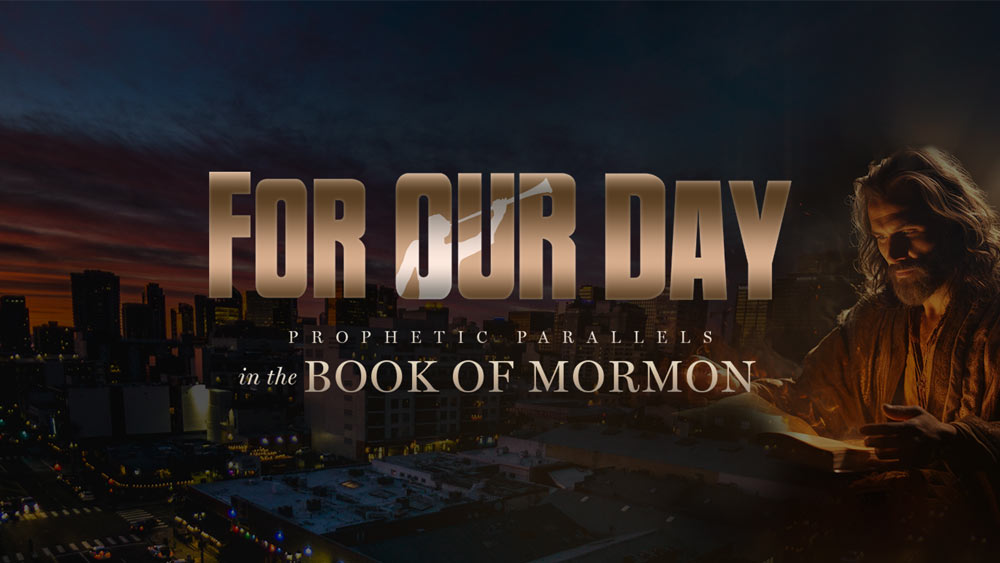Prophetic Statements
Brigham Young
The traditions that we have imbibed in the several countries in which we have been born, and under the various circumstances under which we have been raised, offer a wide field for reflection, and in passing judgment upon each other’s acts a great deal of charity is necessary. The people of one nation will do a thousand things, and, according to their traditions, feel themselves perfectly justified, which those of another nation, with their traditions, would not consider it right to do. How would it look here in the United States of America to enter a large meeting house like this, move out the benches, and then for a congregation to enter the house, kneel down and say a few words of prayer, get up and begin to waltz around to the music of the organ? This would be considered a very strange proceeding among the people of America; yet in other countries it is done and is considered most sacred; and it is in accordance with their traditions. People’s notions of honesty as well as of worship differ very widely, and this difference of opinion is the result of the traditions they have imbibed; and for any persons to say we will bring a motley mass together from various countries, and we will judge all of them by our standard, would be diverging somewhat from the path of truth and justice. Still, notwithstanding the various traditions we have severally imbibed, we are all capable of coming to a perfect understanding of truth and justice, and of what we should do to be perfectly right before God. This is a subject I have reflected upon a great deal, and I have come to the conclusion that we shall be judged according to the deeds done in the body and according to the thoughts and intents of the heart. (Complete Discourses of Brigham Young.)
John Taylor
I remember the time very well, and many of you do, when we used to commence our theatrical amusements here by prayer. We do not do so much of it now. . . . All our acts should be sanctified to God. You know that we are in the habit of having parties occasionally. I will give you my ideas about some of them. I have attended one or two lately, and I think we are running rather wild, and we do not act as much like gentlemen and ladies as we should, nor quite as much like saints as we ought to do. I think there is a great deal of impudence and pert- ness, a great amount of interfering with other people’s rights in these places, and I think that we need correcting, . . . I think we ought to elevate everything of this kind to its proper standard. We ought not to intrude upon or take advantage of anybody, even in amusements.1
David O. McKay
(1) THE ENCLOSED statement of acceptable dancing states that if one concentrates on good dance posture, many dances can be danced in a manner which will meet LDS standards. Examples of these dances are the waltz, the fox trot, tango, rhumba, cha-cha, samba, and the swing, and most of the folk dances, for which the Brigham Young University has a very wholesome and fine reputation.
The seven dances which I have enumerated have all been approved by the General Boards of the Mutual Improvement Associations. This should provide a sufficient variety of dances to enable the youth of Zion to have a good time.
AFTER ALL, young men and women of our Church should shun even the appearance of evil, and that is why we would very much prefer that you and others avoid the current trend of what, to many of us, appears to be vulgar dancing. There are too many fine things in this world for the young people to engage in without resorting to dances that are questionable.
I HOPE THAT you and your friends will follow my advice by dancing in accordance with the standards. You will find that when you accept those standards you will get much more joy and wholesome satisfaction than you do from the questionable dancing engaged in by many, and you will not be in an atmosphere where there is smoking or drinking as described by you in one of the places where you dance.2
Later they built the Social Hall. Perhaps there are those in the audience today who, after listening to the opening prayer, joined hands in the cotillion, dancing in a spirit best understood by the remarks of President Brigham Young, who once said, in substance: “The atmosphere of the dance should be such that if any elder be called from the party to go to administer to a sick person, he could leave with the same spirit that he would go from his elders’ quorum meeting.”3
Harold B. Lee
I could only wish in your dancing parties that you would encourage frequent changes of partners during the evening, as well as group dances, and faster dances of beauty and grace with music that makes an appeal to beauty and harmony rather than to boisterous performances that might well be confined to the circus or the vaudeville stage.4
Spencer W. Kimball
Group music activities have similar effects, and also can soften and mellow the spirit and satisfy the aesthetic needs.
The properly conducted dancing party can be a blessing. It provides opportunity to spend a pleasant evening with many people to the accompaniment of music. It can create and develop friendships which will be treasured in later years. Alternatively it can become a restricting experience.
Well-ordered dances provide favorable places, pleasing times and auspicious circumstances in which to meet new people and to enlarge circles of friends. They can be an open door to happiness. In an evening of pleasurable dancing and conversation, one can become acquainted with many splendid young folk, every one of whom has admirable traits and may be superior to any one companion in at least some qualities.
Ezra Taft Benson
Youth leaders, are you holding aloft our standards, or have you compromised them for the lowest common denominator in order to appease the deceived or vile within the Church? Are the dances and music in your cultural halls virtuous, lovely, praiseworthy, and of good report,5 or do they represent a modern Sodom with short skirts, loud beat, strobe lights, and darkness?6 7
Attend dances where the music and the lighting and the dance movements are conducive to the Spirit.8 9
Have you noticed some of our Church dances lately? Have they been praiseworthy, lovely, and of good report?10 “I doubt,” said President David O. McKay, “whether it is possible to dance most of the prevalent fad dances in a manner to meet LDS standards.”11 12
Satan uses many tools to weaken and destroy the home and family and especially our young people. Today, as never before, it seems the devil’s thrust is directed at our youth. A letter from a concerned father, a well-informed teacher of youth, about the evil effects of some popular music is one of many:
Music creates atmosphere. Atmosphere creates environment. Environment influences behavior. What are the mechanics of this process?
Rhythm is the most physical element in music. It is the only element in music that can exist in bodily movement without benefit of sound. A mind dulled by drugs or alcohol can still respond to the beat.
Loudness adds to muddling the mind. Sound magnified to the threshold of pain is of such physical violence as to block the higher processes of thought and reason. (And turning down the volume of this destructive music does not remove the other evils.) . . .
Repetition to the extreme is another primitive rock device. . . .
Gyrations, a twin to rock rhythm, are such that even clean hands and a pure heart cannot misinterpret their insinuations. . . .
Darkness [and dimmed lights] is another facet of the rock scene. It is a black mass that deadens the conscience in a mask of anonymity. Identity lost in darkness shrinks from the normal feelings of responsibility.
Strobe lights split the darkness in blinding shafts that reduce resistance like the lights of an interrogator’s third degree or the swinging pendulum of the hypnotist who would control your behavior. . . .
The whole psychedelic design is a swinging door to drugs, sex, rebellion, and Godlessness. Combined with the screaming obscenities of the lyrics, this mesmerizing music has borne the fruit of filth. Leaders of the rock society readily proclaim their degeneracy. . . .
And the most diabolical deceit of this infamy is that it denies evil to be an absolute. Our religion is one of absolutes and cannot be rationalized into a relativistic philosophy of the “liberal Mormons.” We cannot safely rationalize away righteousness.
What could be more misguided than fear that “if rock music were not endorsed by our leaders, we may lose many young people.”13 Even now we are losing them to the songs of Satan, drugs, sex, riot, and apostasy. We could be well reminded by a message from the Mormon Miracle pageant: “Moroni knew that you cannot compromise with evil. If you do, evil always wins.”14
This letter from a father, teacher of youth, and member of a college music department, although analytical, expresses the concern of many other parents and youth leaders.
The Church must not compromise standards before popular demands. Surely tobacco, coffee, and alcohol users have been alienated by uncompromising standards as much as today’s rocking miniskirts.15
We attach to most of our chapels a cultural hall so that our youth may have a place to dance, to perform their talents in musicals and other uplifting entertainment, and we hope our youth leaders as trustees of the building will see to it that only wholesome, uplifting activities are performed in this building. Should you have any reservations whether or not an activity, a style of dancing or tempo of music is in accord with Church standards, may I suggest this guide: Does it uplift and inspire one to higher ideals? Does it develop wholesome relationships between young men and women, or appeal to and arouse their baser instincts? Will it cause one to be a better Latter-day Saint and lead one closer to the Savior? Avoid all activities and dances which bring the world’s demoralizing standards into this sacred meeting place. If you adult leaders will counsel the youth, they can understand the inconsistency of opening our meetings with prayer asking that the Lord’s Spirit be with us, and then engaging in an activity which repels His Spirit. We ask you to be very mindful of this.16
Our young people must lead clean lives-clean in their actions, clean in their thoughts. This means that they cannot indulge promiscuously in so-called petting and necking. My advice to them would be not to engage in these promiscuous relationships, these close and intimate contacts including cheek-to-cheek dancing on the ballroom floor, whether it be at a Church dance, a public dance, or wherever it might be. I urge that they never do anything, on the dance floor or off the dance floor, that they would be ashamed to have their own fathers and mothers witness.17
Scriptures
Nephi 18:9
And after we had been driven forth before the wind for the space of many days, behold, my brethren and the sons of Ishmael and also their wives began to make themselves merry, insomuch that they began to dance, and to sing, and to speak with much rudeness, yea, even that they did forget by what power they had been brought thither; yea, they were lifted up unto exceeding rudeness.
Mosiah 18:9
To stand as witnesses of God at all times and in all things, and in all places that ye may be in, even until death, that ye may be redeemed of God,
Rock Artists
Supporting Statements
“For The Strength of Youth” pamphlet
Dancing can be fun and can provide an opportunity to meet new people. However, it too can be misused. When dancing, avoid full body contact with your partner. Do not use positions or moves that are suggestive of sexual behavior. Plan and attend dances where dress, grooming, lighting, lyrics, and music contribute to a wholesome atmosphere where the Spirit of the Lord may be present.18
- John Taylor, Journal of Discourses,15:270-272, January 5, 1873;, p. 62. ↩︎
- David O. McKay, as printed in the Daily Universe, Dec. 3 1965, pp. 1-2; and Living Prophets for a Living Church, Church Educational System college student manual, 1974. ↩︎
- David O. McKay, Pathways to Happiness, p. 72. ↩︎
- Harold B. Lee, Decisions for Successful Living [Salt Lake City: Deseret Book Co., 1973], 156 – 157. ↩︎
- Article of Faith 13. ↩︎
- God, Family, Country, p. 229. ↩︎
- Ezra Taft Benson, The Teachings of Ezra Taft Benson [Salt Lake City: Bookcraft, 1988], 323. ↩︎
- “To the Young Women of the Church,” Ensign 16 [November 1986]: 84. ↩︎
- Ezra Taft Benson, The Teachings of Ezra Taft Benson [Salt Lake City: Bookcraft, 1988], 326 – 327. ↩︎
- Article of Faith 13. ↩︎
- CR April 1969, Improvement Era 72 [June 1969]: 46-47. ↩︎
- Ezra Taft Benson, The Teachings of Ezra Taft Benson [Salt Lake City: Bookcraft, 1988], 325. ↩︎
- MIA Music Committee. ↩︎
- Richard Nibley, excerpts from letter. ↩︎
- Ezra Taft Benson, God, Family, Country: Our Three Great Loyalties [Salt Lake City: Deseret Book Co., 1974], 242. ↩︎
- Ezra Taft Benson, Finglas Ireland Branch Dedication, 10 September 1980;Teachings of Ezra Taft Benson, p. 153. ↩︎
- Ezra Taft Benson, Teachings of Ezra Taft Benson, p. 323. ↩︎
- For the Strength of Youth. ↩︎







